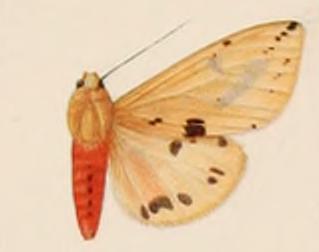
Eupsilia transversa, the satellite, is a moth of the family Noctuidae. The species was first described by Johann Siegfried Hufnagel in 1766. It is distributed throughout the Palearctic.

Athyma selenophora, the staff sergeant, is a species of nymphalid butterfly found in tropical and subtropical Asia.

Atethmia centrago, the centre-barred sallow, is a moth of the family Noctuidae. The species was first described by Adrian Hardy Haworth in 1809. It is found in Europe except Scandinavia and Italy; also in Asia Minor, Armenia, Syria and Palestine.

Hydraecia micacea, the rosy rustic, is a moth of the family Noctuoidea. It is found across the Palearctic realm from Ireland to Siberia. It reaches Japan and is introduced to eastern USA, Quebec and Ottawa.

Ischyja manlia is a species of moth of the family Noctuidae first described by Pieter Cramer in 1776. It is found in the Indian subregion, Sri Lanka, Myanmar, Thailand, China, Okinawa, Sundaland, Sulawesi, Korea, the southern Moluccas, Australia (Queensland) and Palau. Adults pierce the skin of fruit to suck the juice.

Spilosoma fumida is a species of moth of the family Erebidae. It was described by Alfred Ernest Wileman in 1910. It is found in Taiwan.

Lophocampa affinis is a moth of the family Erebidae. It was described by Walter Rothschild in 1909. It is found in Mexico.

Spilosoma roseata is a moth of the family Erebidae. It was described by Walter Rothschild in 1910. It is found on Java in Indonesia.

Spilosoma batesi is a moth of the family Erebidae. It was described by Walter Rothschild in 1910. It is found in Nigeria, Cameroon, Congo and Zaire.

Ichneutica oliveri is a moth of the family Noctuidae. It is endemic to New Zealand, found only in the South Island. However it has not been observed on the eastern side of that island from mid-Canterbury southwards to Southland. This species is distinctive and is unlikely to be confused with other closely related species. It inhabits tussock grasslands, shrubland as well as granite sand plains, all in the alpine zone. Adults are on the wing from December to March and are attracted to light. They have been observed feeding on the flowers of Hebe species. The life history of this species is unknown as are the larval hosts.
Ambia chrysogramma is a moth in the family Crambidae. It was described by George Hampson in 1917. It is found on Samoa.
Ambia melanalis is a moth in the family Crambidae. It was described by George Hampson in 1906. It is found in South Africa.
Syllepte xylocraspis is a moth in the family Crambidae. It was described by George Hampson in 1912. It is found in South Africa.
Syllepte maculilinealis is a moth in the family Crambidae. It was described by George Hampson in 1918. It is found in Uganda.
Syngamia albiceps is a moth in the family Crambidae. It was described by George Hampson in 1912. It is found in Singapore.
Udea binoculalis is a moth in the family Crambidae. It was described by George Hampson in 1904. It is found on the Bahamas.
Udeoides nigribasalis is a moth in the family Crambidae. It was described by George Hampson in 1913. It is found in Kenya.
Thymistadopsis albidescens is a moth in the family Drepanidae. It was described by George Hampson in 1895. It is found in the Indian states of Sikkim and Assam.
Nothoploca nigripunctata is a moth in the family Drepanidae. It is found in India, Vietnam, Korea, China and the Russian Far East.

Ichneutica chlorodonta, also known as the Green-toothed Owlet, is a moth of the family Noctuidae. This species is endemic to New Zealand. It is found throughout the North, South and Stewart Islands and is associated with native forest and shrubland. It can be confused with similar looking species such as I. subcyprea however I. chlorodonta can be distinguished through differences in colouration of its fore and hind wings as well as the length of the male pectinations. The life history of this species is unknown as are the host species of its larvae but adults of I. chlorodonta are on the wing from September to April.








